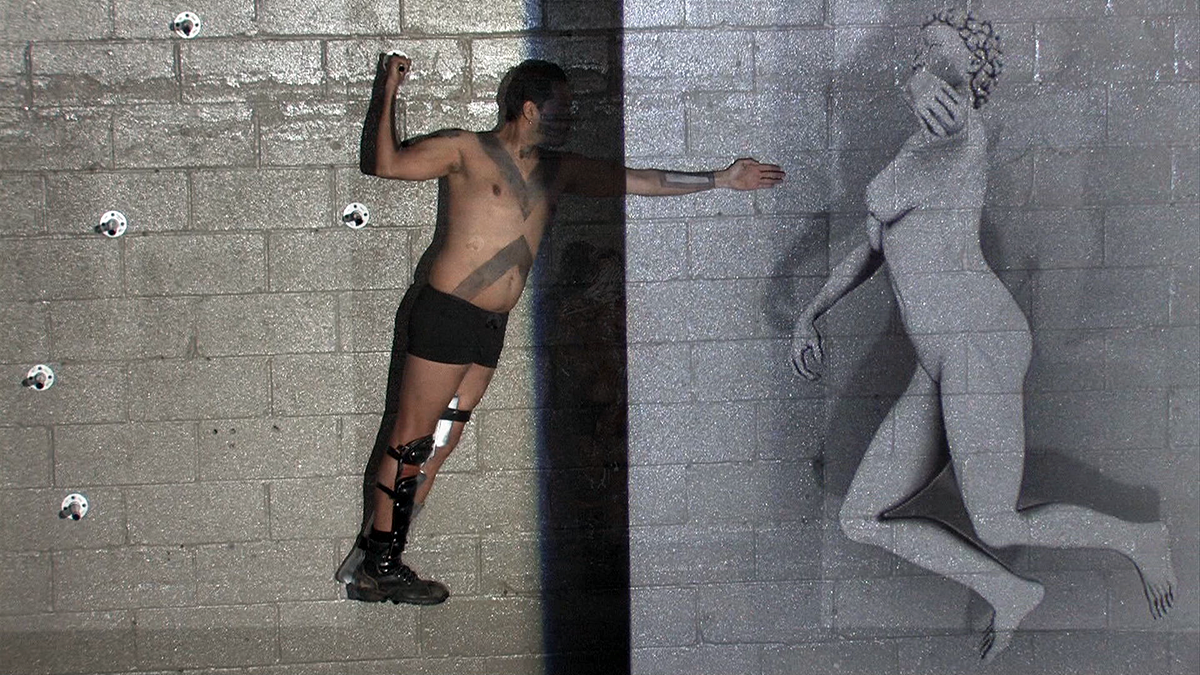




A digital-dance performance object
Black & White Project Space
Brooklyn, NY, October 28, 2011
2.5 minute documentation, Claudia Hart
Animation Installation by Hart; Performance by Roberto Sifuentes; Music by Edmund Campion
The Recumulations 3D animation installation is the basis of this site-specific performance-installation in which the dancing avatar is conceived of as a grotesque architectural element like a virtual caryatid or a gargoyle. The performance object can installed for a single weekend or a single day, and is modular and systematic in a fluid and flexible way. It can be adapted to any location in time or space.
Roberto Sifuentes performed In the courtyard of the Black and White Project Space in Williamsburg in November 2011 for four hours.
As a very young artist, I was inspired by a cultural critique, On the Grotesque: Strategies of Contradiction in Art and Literature, by Geoffrey Galt Harpham (Princeton, N.J.: Princeton University Press, 1982). Harpham described the grotesque or "grotto-esque" as emerging from "a general sense of historical deterioration and decay." Grotesque manuscript illuminations and Gothic gargoyles were the first decorative yet impossible forms, merging the animal, the vegetable and the human into the monstrous creatures of a cultural unconscious. Harpham traces those medieval forms touching on a historical trajectory that can trace a line between Bosch, Bruegel, Goya, 18th century political satires and parodies, Aubrey Beardsley, Mary Shelley's Frankenstein, Grimm's fairy tales, Max Klinger and Gustav Klimt to Francis Bacon and David Lynch. The Grotesque then, can also be seen as the source of creativity itself, that place in the mind where thoughts and order just begin to emerge from primal stew and rational categories have not reified. The Recumulations' Grotesque dwells in the shadow of the Bush regime and the 2009 economic collapse, suggesting political and social decay and the fall of empires. Decay: the one thing that still is dealt democratically to all, when even in the flush of life, the unpleasant perfume of carrion still pervades - Baudelaire's fleur du mals.
The basis for the performance is the animation Recumulations, which reconsidered Primary Accumulation (1972), the seminal dance film made by Trisha Brown, in the context of post-analog media. It re-examined possibilities first proposed by Brown in her choreography for a real body recorded by video but now contemporized as a virtual body performing within non-linear digital space as a 3D animated film. It was originally produced for the Black & White Gallery / Project Space, a site-specific not-for-profit art center in Williamsburg, Brooklyn, in dialog and with support from Tatyana Okshteyn, its Founding Director. I'd seen Noemie Lafrance's Melt premiere at Black & White in 2003, and it melded with the Brown work in my conception.
The composer Edmund Campion, Director at CNMAT (The Center for New Music and Audio Technologies) has created a malleable digital score for RECUMULTIONS. Campion's work proposed a hybrid music, merging digital technologies with more traditional musical forces. Intuitive music fragments and processes (often inspired by physical improvisation) are built into complex digital systems. His compositional strategy strongly reflects that of Hart and Sifuentes. The unique Recumulations music software was created with support from CNMAT and former CNMAT Music Systems Designer, Matthew Wright.
On October 28th, 2011, during his live performance in the raw and stripped down environment of Black and White Gallery's Project Space, Roberto Sifuentes mirrored and responded to large-scale projections of his motion-captured performance, used by Hart as the basis of her animation. The display of Sifuentes' live body revealed the continuum from real to virtual, recombining movement, affect and interface at the level of performance. Eerily reminiscent of the sci-fi/horror classic, Videodrome, but created decades later, Hart and Sifuentes did not express the same sense of fear and anxiety about media as was conveyed by the David Cronenberg 1983 film. Recumulations instead conveyed a kind of grotesque beauty, reflecting the artist's embrace of a contemporary world in which the fantastical artificiality made possible by advanced technologies has long since passed over the boundary of the real.
Recumulations was funded by The School of the Art Institute of Chicago,The Ellen Stone Belic Center for the Study of the Women and Gender in the Media and Art, and the University of California, Berkeley. Additional support was provided by Black & White Project Space with public funds from the Rockefeller Brothers Fund.